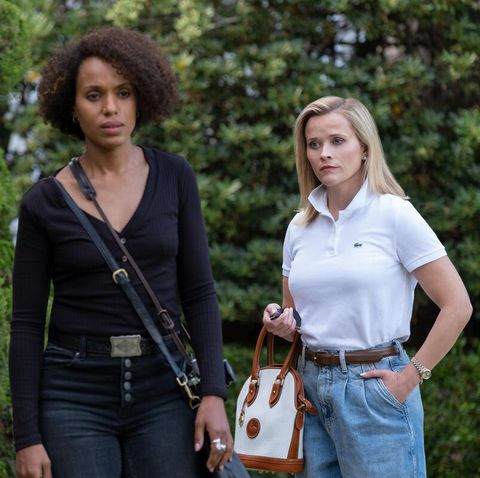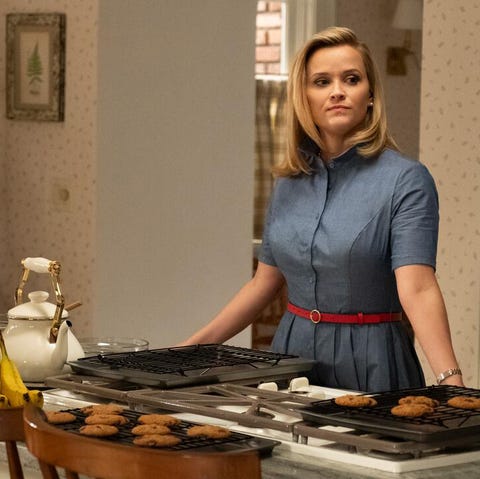Like the quaint Cleveland suburb of Shaker Heights, where Hulu’s Little Fires Everywhere sets its stage, everything was planned to be perfect. In 2017, the Celeste Ng book seemed invincible. The number one New York Times bestseller landed on nearly every best-of-the-year book list, and Reese Witherspoon, an early champion of the novel, gave it her Midas touch: a coveted Reese’s Book Club sticker the month it came out. Then her famed production company, Hello Sunshine, teamed up with Kerry Washington’s Simpson Street to option the book for TV. The first three episodes of that eight-part adaptation just hit Hulu, with Ng serving as producer. So why isn’t the show a masterpiece?
Little Fires follows two polar-opposite mothers, Elena Richardson (Witherspoon, in her element as a wealthy type-A blonde) and Mia Warren (Washington, using her ferocity à la Olivia Pope to breathe complexity into a starving artist). It’s the summer of 1997, and Mia, with her daughter Pearl in tow, has just arrived in picturesque Shaker Heights, where the grass must be kept under six inches and the duplexes conceal their secondary front doors to avoid damaging curb appeal. Mia has raised Pearl mostly from the backseat of her car, but decides to settle in the suburb to work on her next project. Elena, an overachieving mother of four high schoolers, considers renting to Mia an act of charity. The two women might become friends—or at least planets in the same orbit—until Mia meets Bebe Chow. Bebe’s predicament as an undocumented immigrant who gave up her child out of desperation sharpens the contrasts between Elena and Mia until their collective secrets set their lives ablaze.
The show is compulsively binge-able, a firestorm of star power and mystery sprinkled with insightful performances that propel you into the next episode. But, as many critics have already noted, the adaptation never quite rises to the power of its predecessor—in many cases because it scrambles and alters its source material in diminishing ways. Below, ELLE.com breaks down how the series diverges from the book, episode by episode, and what those changes mean for Ng’s original story.
(Spoilers for Little Fires Everywhere below. Updates will be added weekly after each episode is released.)
Episode 1: “The Spark”
The Warrens Are Discovered, Not Introduced
In the harried first moments of the premiere, little seems different from the book. We watch how the story ends: Elena Richardson stares at the crumbling remains of her home, burning to embers.
But as the show flashes back to four months prior, it continues Elena’s story. She starts her day checking her weight and preparing her husband’s coffee before work. Bright and enthusiastic, she’s the ideal suburban mother. A normal day awaits her, until she drives past a car in a parking lot, where she sees a woman sleeping. Elena calls the police to investigate.
And so we meet Mia and Pearl Warren (Lexi Underwood), but their introduction in the book is much different. Though chapter one opens with the Richardsons watching their house burn, chapter two introduces the Warrens merely as recent Shaker transplants. There’s little about them that raises Elena’s perfectly plucked eyebrows. The show, instead, introduces them through Elena’s suspicious gaze: as a problem, an unsightly blemish on her otherwise spotless neighborhood. When they want to rent from her, she agrees partly out of guilt. This stigma sticks to them throughout the series.
The Warrens Are Black
Immediately, the show introduces a crucial change from the source material: Mia is black. In Ng’s novel, Mia’s race is never explicitly mentioned, though we are to assume she is white; the class division between her and the rest of Shaker is stark, sure, but we know her life would look markedly different if she was black. This is what Hulu’s adaptation explores, and race changes how Mia’s every action is perceived, from dozing in her car to shopping for groceries in a mostly-white neighborhood. This is an excellent choice for the adaptation, as it adds another layer of nuance to Mia and Elena’s coming conflict.
Unfortunately, the show doesn’t always handle this conversation artfully. It’s set in the ‘90s, when “colorblind” politics were all the rage, and Elena takes every chance she can to reference this. When the Warrens first arrive to peruse the Richardsons’ rental, Elena mentions their school: “It was actually one of the first integrated schools in the city!” Many awkward remarks that equate with, “Look at me, being colorblind,” stack up in the two episodes that follow. They plant the initial seed for what could have become a captivating dissection of privilege, but instead, the characters continue to skirt the issue. The comments make the characters seem stubbornly two-dimensional, and they never lead to any honest insight. Hopefully this changes in the episodes to come.
Izzy Suffers From More Than Teen Angst
When Pearl meets Moody (Gavin Lewis), the Richardsons’ sophomore son, we get a closer peek at Elena’s relationship with her youngest daughter, Izzy. They’re not close.
In the book, Izzy is painted as a somewhat archetypal black sheep. She doesn’t like the cookie-cutter life her mother sketched out for her. She responds by arguing, acting out, and pulling pranks on teachers who mistreat her few friends. But the show adds another layer: One of Izzy’s recent friendships has ruptured, and Elena doesn’t know why. She suggests Izzy wear her hair down in an effort to boost her daughter’s popularity. Simple enough, right? But Izzy, in protest, sets her hair on fire.
This is, uh, perhaps a little heavy-handed. Setting up Izzy as a pyromaniac in the first episode gives us little reason to doubt she might be to blame for the subsequent house-on-fire incident. And yet her parents refuse therapy?? Instead, Elena suggests Izzy get “The Rachel.” How we love the ’90s.
Moody and Pearl Are Caught Trespassing
As Moody and Pearl’s relationship deepens, he invites her to his makeshift hideout in a local junkyard. They recite brooding poetry and exchange coy looks…until neighborhood watch discovers them.
Mia, terrified to see a police car pulling up to her driveway, loses it. Elena, who is noticeably calmer—and, in fact, is friends with the neighborhood watchman—tells Mia there’s “no reason to get this upset.” This doesn’t soothe Mia. Later, she tells Pearl, black people “don’t get passes like them.” In response, Pearl lashes out, telling Mia, “Mrs. Richardson puts her kids first,” implying Mia does not.
None of this snapping back and forth takes place in the book. The subtext is there, of course: Pearl wishes for stability, for clarity around her history, for the cozy but inaccessible world of the Richardsons. But by cracking open these wounds with a shouting match, the show erases the book’s more detailed examination of class tension, of empathy and lack thereof. We are encouraged, instead, to pick a side and join the fray.
Episode 2: “Seeds and All”
Mia Has Sex
From the moment the second episode begins, we know exactly what kind of creaking noise we’re hearing. Mia’s having sex with a stranger in her car while Pearl sleeps in the backseat. The show’s treatment of Mia’s sexuality is an enormous shift from Ng’s novel. In the book, Mia is pointedly asexual. She’s never seen an adult man naked. She’s never, as Ng puts it, “felt that warmth, that electric tension.” Yet in the Hulu adaptation, Pearl tells Moody her mother has sex with “whomever she wants, whenever she wants.” Mia tells Pearl sex doesn’t need to mean anything.
This contrasts with Elena, who, comically, schedules sex with her husband for every Wednesday and Saturday. But why such a stark division between the two women? To demonstrate Elena as the overcautious architect and Mia as the careless free spirit? That’s already established. Giving Mia a trait with more mystery, more nuance, more collision against a world that doesn’t understand her—that would have been the bolder choice.
Pearl and Moody Hint At Something More
We knew this would happen. In the book, Moody has a sizable, obvious crush on Pearl, but Pearl never gives him a reason to believe she feels the same. In the show’s second episode, however, the two enjoy some of Mia’s weed stash—another interesting deviation from the book—and collapse on the bed together. They intertwine hands. They talk about sex. The audience starts to wonder.
Mia Rescues Book Club
Much to her chagrin, Elena is tasked with hosting a discussion of The Vagina Monologues for book club. (She unsurprisingly hates the word “vagina” and wanted to read something less controversial, like *cough* Memoirs of A Geisha). The gossip takes a turn as some of the attendees express similar discomfort, while others want to explore the stigma. Mia, who is helping with food and drink, decides to step in.
Only a few hours earlier, Mia stumbled upon a criminal background check of her own name, faxed to Elena’s home office. Now, she jumps in to rescue Elena’s floundering argument at the club, telling the group, “I think Elena is talking about vaginas as a metaphor for our own discomfort with the parts of us that make us most uniquely and primarily who we are.” None of this happens in the book.
Afterward, Elena and Mia share a bottle of wine. They discuss the fax. They discuss motherhood. They giggle and get a little drunk. They inch closer to each other, but then Elena offers to buy Mia’s art. Mia pulls back. The two women never circle each other this closely in the book. Their relationship is more distant and uncomfortable—intersecting but not meshed.
Pearl Leans On Elena’s Leverage
Pearl sits down with a guidance counselor to advocate for a position in a more challenging math course. The man takes one look at her and assumes three things: 1) She’s commuting from Cleveland, 2) The classes would be too tough for her, and 3) She needs subsidized lunch forms. Only the last is true.
Frustrated, Pearl confides in her mother, who tells her she’s a smart girl who can figure it out. Discouraged, Pearl asks Elena for help drafting a letter to the counselor. Elena says she’ll handle it, and goes to the school to make the change herself. When Mia asks about it later, Pearl says she took care of it. But in the book, she makes a point only to omit information when talking to her mother—never outright lying. It’s a trademark of her character and of the mother-daughter relationship. Even in all the chaos, Pearl remains bound to Mia. In the show, she’s already slipping away.
Episode 3: “Seventy Cents”
Mia Pushes Bebe Chow To Find Her Daughter
In the third episode, we’re finally introduced to the main conflict of the novel: Bebe Chow’s legitimacy as a mother. We watch as Bebe (Huang Lu), newborn May Ling in her arms, struggles to get her daughter to latch. An undocumented Chinese immigrant, Bebe has no resources. She has no money for formula. Her lighting and heat is shut off. She does not sleep, and May Ling does not stop crying. Desperate, she leaves the baby at a fire station, where she hopes someone will care for the child until she can.
But the baby disappears. Now working at a Chinese restaurant, Lucky Palace, with Mia, Bebe tells her story. Mia, suddenly lit from within, pushes her co-worker to search for her daughter. There’s an urgency in her tone that doesn’t quite match Mia’s careful, quiet nature in the book. We know immediately that Mia has a stake in this.
Lexie Steals Pearl’s Essay
Lexie (Jade Pettyjohn), Elena’s eldest daughter, will get into Yale. She will. There is no question. But in order to do so, she has to write an essay about a “hardship” she’s endured. Worried her glittering, conflict-free life won’t cut it, Lexie decides to use Pearl’s story—remember the counselor?—as her own, substituting gender discrimination for racial prejudice. She feels justified because, later, she takes Pearl dress shopping.
Lexie reads her modified essay aloud to her boyfriend, Brian, who is black. He’s doubtful Lexie actually experienced this trauma, and later, he learns the truth: Lexie’s essay wasn’t “inspired” by anything. It was taken from Pearl and transformed for Lexie’s benefit. He tells Pearl the truth at the school dance. In the book, Pearl offers to write Lexie’s essay for her, but the show doesn’t give her the chance to make that decision.
Izzy Is Targeted for Her Sexuality at School
At dinner, Trip refers to Izzy as “Ellen.” Her face freezes, and she leaves the table. When Elena expresses confusion, Moody explains, “Like Degeneres, Mom.” Elena confronts her daughter about this later, on the way to school. She tells Izzy, “If they’re saying something untrue, then you should change the story.” She wavers. “Are they saying something untrue?”
“Of course it’s untrue,” Izzy snaps.
In the book, Izzy’s sexuality is never explored. Her status as a social pariah has less to do with her orientation than with the singled-out attention her mother bestowed on her from early childhood. The show’s inclusion of another complicated social construct—heteronormativity—is an interesting and admirable one, but the piling of conflict over conflict, identity over identity, starts to rub away at the core of the characters until they’re better defined as archetypes.
Later in this episode, Izzy is accused of sexually assaulting a female classmate.
Bebe Crashes Her Daughter’s Birthday Party
When Elena lets it slip to Mia that her best friend, Linda McCullough, recently adopted a Chinese baby who was found abandoned at a fire station, Mia nearly trips over herself to get out the door. Later, she offers to photograph the baby’s birthday party, and when she discovers a distinctive birthmark on the back of her head, rushes to tell Bebe.
Against Mia’s advice, Bebe insists on seeing May Ling (now Mirabelle) immediately, and rushes to the party. As Elena brings in the cake with a single fluttering candle, Bebe bursts through the front door, screaming, “That’s my baby!” The party devolves into hysterical shouting, and two guests drag Bebe out of the house. This does not happen in the book. The chaos makes for great television and a hell of a cliffhanger for the first three episodes. But there’s also something off about this scene. It makes Bebe seem deranged, unjustified rather than simply unwelcome. Once again, nuance is cut out of the story in favor of melodrama. Ng’s work thrives on subtlety, on what’s understood but unsaid. There’s nothing subtle about this.
Next week, we’ll tackle the differences in episode 4. Hopefully, Washington’s acting chops can right the course.





